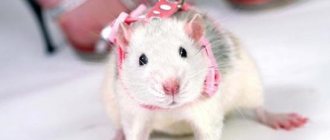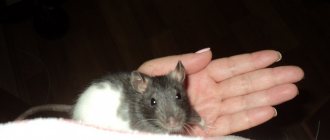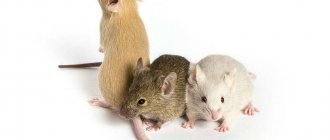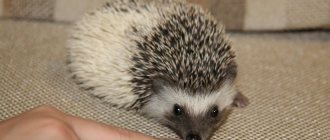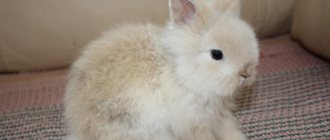Animal lovers have very different preferences: some love cats, others prefer smart and loyal dogs, while others can spend hours watching the life of underwater inhabitants. And for some, there is no better pet than a decorative (or domestic) rat. Are you surprised? But the history of the domestication and taming of rats dates back to the Middle Ages.
The first decorative individuals, descendants of the now popular pets, appeared at the beginning of the 20th century. The domestic rat (reviews from the owners allow us to judge this) are distinguished by high intelligence, quick wits, cunning and memory, which many people can envy. It is these characteristics that contribute to the maintenance and growth of their popularity.
Even people who, to put it mildly, have a cool attitude towards rodents, watch with pleasure and interest the tricks that decorative rats easily master and demonstrate. In this article we will tell you everything about these pets. You will find out how long a rat lives at home, what it should be fed, what it likes and what it does not accept.
Description
The domestic decorative rat is a small animal. The male weighs about 600 grams, the female is twice as small - 300 grams. Body length is from 8 to 25 centimeters. The build and shape of the muzzle depend on the breed, but most often they have an elongated nose. The body is covered with fur, the density of which also depends on the breed, the tail is almost bare, up to 18 centimeters long, and the legs are short. The color is often monochromatic - red, white, black, gray.
At the same time, among some breeds there are individuals with two-color coats. The color of the eyes also depends on the color, for example, white rats have pink eyes, gray rats have black eyes.
Types and breeds of decorative rats
There are many varieties of these animals, but some of them are more suitable for keeping at home. They differ in coat type, size and life expectancy.
Standard
An animal with smooth shiny fur. This is the most common type of pet rat and can be purchased at almost every pet store.
Sphinx
Today this domestic rat is not very common. Reviews from owners indicate that this is a wonderful pet that is suitable for owners who are allergic to animal fur. Sphynxes have virtually no hair (there may be sparse fluff on the ankles, under the eyes and in the groin).
Dumbo
Larger animals with low-set round and large ears. This variety was developed in California (1991). The breed was named after the cartoon character Dumbo the elephant.
The head is round and wider than other breeds, and the muzzle is pointed. The body shape is pear-shaped, but shorter than that of tailless individuals.
Anurans
The peculiarity of this rodent is clear from the name of the breed, which is the result of a mutation. The first tailless rat was obtained not from a scientific laboratory, but from an amateur in the UK in 1983. This variety differs, for example, from the standard breed in body shape - it is pear-shaped. Representatives of tailless rats should not even have the rudiment of a tail.
Satin
This domestic rat has a special coat. Reviews from owners indicate that it is thinner and longer than other breeds. The body of satin rats has the same shape as that of animals of the standard breed, and the coat has a strong shine. It is thick and very pleasant to the touch.
Double Rex
Representatives of this breed have double hair. The fur is so short that the skin is clearly visible through it, while the fur is twisted into large spirals. Hard guard hairs and soft downy hairs are scattered throughout the body. You need to know that rats of this breed shed.
During this period, in some areas there is a temporary complete absence of hair, sometimes covered with a thin layer of fluff. Color may vary. The mustache is curled and short.
Breeds of rats
Sphynx rat
Curly rat
Tailless rat
- Female or male?
Implicit external differences between rats of different sexes nevertheless give rise to obvious differences in behavior.
Males are suitable for an owner who is going to take his little friend with him everywhere, since male rats become more attached and are calmer. True, their disadvantage is uncleanliness or, more simply, a natural need to mark territory.
Females, as in the human world, look after themselves and the surrounding territory, but will not sit on your shoulder or in your pocket, preferring freedom of action.
- Place of purchase.
You must buy an animal from a trusted place with a good reputation and all the documents and certificates for the animal. Here it is better to play it safe than to bring an unknown infection into your apartment.
- How to choose a healthy animal.
A healthy baby rat is inquisitive - this is its main quality and the criterion by which you should choose an animal in a store. The animal, which became interested in the hand brought to the cage, calmly came up to sniff and communicate, demonstrating the most natural behavior for a healthy individual. Lethargic, half-asleep animals or, on the contrary, overly excited animals should not inspire confidence in buyers. When purchased, the rat should be between a month and a half old - not too young to have already acquired all the skills necessary for life from its mother, but not too old to quickly get used to its new owner.
When you first examine a rat in a store, there should be nothing alarming. Namely, it should not be:
- damage to the paws, tail or other parts of the body;
- inflammation, bald spots or parasites on the skin and coat;
- discharge from the eyes, nose or ears;
- dirt on the anus (this would mean diarrhea, which is difficult to cure in rats);
- sneezing or uneven breathing, indicating a cold.
If, when purchasing, there is at least something alarming about the appearance of the rat, you should not buy it, especially out of pity, since the consequences of such a choice can be the most disastrous.
Lifespan
On average, pet rats live about 1.5-2 years, but with proper care this period can increase to 4 years. In addition, you should know that you should purchase an animal from breeders, nurseries or pet stores, but not at the poultry market. Only in this case, you will receive a guarantee that the animal is healthy and is not a carrier of serious diseases.
We hope that, knowing how long a rat lives at home, you will take the choice of an animal seriously and create the necessary conditions for it.
Short
Keeping a rat is considered one of the simplest, compared to caring for other types of pets. Rats are easy to train, they are loyal and sociable, and friendly towards humans. Tame animals love to spend time with small children, but adults will not get bored with them either. Rats especially love it when their owner scratches their belly or behind their ears. They can spend hours next to their owner without intruding on him.
Some types of rats choose favorites among members of a large family, but willingly communicate with everyone. If the owner is sad and the animal feels it, he can try to cheer him up with funny faces or sounds. Rats are one of the few pets that can laugh when tickled.
The average lifespan of rodents is about 2 years. However, if the owner is able to provide the pet with adequate care, it can increase to 4 years. Rats are so unpretentious to care that even a junior high school student can handle it, with whom rats often become best friends.
Rodents in the wild live a nocturnal life, and during the day they sleep, preparing for the next hunting trip. If the rat is smart, then you can accustom it to daytime. And if a person himself is an owl by chronotype, then there is no point in changing the rhythm of the pet’s life; it will not interfere with everyday life. You can sometimes frolic with your pet at night; owners say that at night, contact with the animal is felt on a deeper level, when no one is distracting.
A rat is a rodent from the mouse family, which has more than 64 species. Rats began to be kept as pets in the 19th century, and in the process of breeding new breeds, they began to differ from their wild ancestors. During the breeding process, the calmest rodents were selected to prevent future outbreaks of aggression towards people.
But, despite the fact that the ornamental rat has a different character than its relatives living in the wild, it is very important to purchase a pet from a trusted place, which is bred and kept in the necessary conditions and does not have diseases. By purchasing such a rat, you can be sure of its safety.
A trusted place means purchasing an animal from a reputable breeder or pet store. When buying a rat from a pet store, pay attention to how they are kept: cages must be clean, food bowls must be filled with fresh food and clean water. The animal must be active: if the animal is lethargic and does not show activity, this may indicate its illness.
Keeping decorative rats at home
If you are going to get such a pet, then you need to know that these animals need communication. We are not talking about three minutes of contact through the bars. The rodent should sit on your shoulder or in your arms, sniff you from head to toe, taste you as its owner and closest and only friend.
In addition, rats should be given the opportunity to move more or less freely around the apartment, since they need movement. First, allow your pet to master a limited area (for example, one room) under the close supervision of the owner, then, when the animal begins to respond to its name and comes running to the sound of your voice, you can let it go for a walk throughout the entire apartment.
So, we have determined that the decorative rat, as a pet, needs communication and a real need to move freely. At the same time, she needs her own home. The owner must know how to handle the animal, what to feed it and what kind of character the pet has.
Benefits of rats as pets
- Rats are highly intelligent
They can learn tricks and commands such as fetching things for you, answering their name, etc. These rodents can also solve puzzles and collect treats you have hidden. There are even pet rats that are trained to find mines for the military. They are also very easy to litter train, making cleaning up after them much easier.
- Domestic rats are clean
They spend most of their day simply licking and preening themselves. This makes caring for them much easier. As mentioned earlier, they can also be litter box trained.
- They are inexpensive
If you are on a tight budget, a rat may be the perfect pet for you and your family. They are also inexpensive to care for. The owner will have to spend money on a cage and a few toys for them, but overall rats are pretty inexpensive.
- These rodents do not require special care
They don't need walks, they very rarely need grooming, and although their diet should be healthy and varied, there are relatively few foods that they cannot eat. And being active at night, they don't mope when their owner goes to school or work - they just sleep.
Most of the work you will have to do is cleaning their cage from time to time and changing their litter box to keep the room and cage odor-free. They also need attention, but this applies to all pets.
- They are very affectionate and easily get attached.
Not only among themselves, but also with their owners. In fact, domestic rats recognize their owner very easily using different senses. They will actively search and play with other rats and you. Pet rats will also sleep together almost all the time.
They enjoy cuddling with you, playing with your hands and enjoying being petted if they are used to it from an early age. They even do something called "bruxing." Pets chatter their teeth to show their love for you.
But the degree of their affection depends on several things. If they are not yet used to you, they may appear skittish and run away from you. You need to gain your pets' trust by giving them treats, spending some time with them, letting them get to know you better, and so on.
This is why it is so important to pay attention to your pet rat!
Not only will they become more affectionate by spending more time with you, but they will also feel happier. Pet rats are extremely susceptible to depression, which most often occurs due to not receiving enough attention for a long time. This happens quite often, especially if you only have one rat (which you shouldn't do, always get a pair).
The way you express love also depends on the gender of your rat. Male pet rats tend to be lazier and want to cuddle more often. While female rats are often more energetic, very curious and always on the move, they will often need to play with you.
- Pet rats make great first pets for children
Since they are fairly low-maintenance pets, they are ideal for small children. It will be easy for the child to learn to take care of them. By caring for a rodent, children will be able to learn about the responsibility of having a pet and will have a buddy with whom they can chat at any time.
- Each rat has its own personality
They are very emotional and react to things differently. For example, some pet rats will love to chew on toys and will destroy and chew on everything. While others will want to run after balls and push them. Some people will enjoy being picked up and riding on your shoulders. Others will just want to lie on your lap and sleep. There are many different pet rats, and you never know which one will be yours.
- Rats are not too big and not too small
They weigh between 200g (little girl) and 700g (big boy) at maturity and have a firm, robust body shape. This makes them quite easy to handle, even for children. But a couple of rats in a decent cage still doesn’t take up much space in the house.
Rat character
This phrase sounds intimidating and even a little unpleasant. But in reality, the domestic rat (owner reviews indicate this) has an excellent character and a number of advantages that make this rodent a favorite pet in many families.
A rat, as a pet, is not inferior to a cat in terms of cleanliness. She also washes her face frequently. If the cage is cleaned properly and in a timely manner, there will be no unpleasant odor in the house. Keeping a pet rat can be combined with training this animal. Don’t be surprised, but these animals, like dogs, can perform various commands - “stand”, “lie down”, “sit” and others. A treat will help you achieve results.
We can say that rats are omnivores. But in this article we will tell you what you should not feed these rodents. It is very interesting to watch these animals in a well-equipped cage: with a wheel, all kinds of rings and pipes. Rats deftly use their tails and their prehensile paws.
Setting up a house for a rodent
Aquariums are not suitable for this animal due to poor ventilation, and cages for hamsters are not suitable due to their small area. A cage for a pet rat should be special. This is, rather, a two-, or better yet, a three-story house, a kind of cottage with many different exercise equipment.
In addition to its impressive size, a house for a rat must meet the following requirements:
- the cage must be made of durable metal rods, which are spaced at a distance of 10 mm;
- a deep tray is required;
- all exercise equipment should be securely fastened;
- it is necessary to install a drinking bowl with clean water in the house; as a filler it is better to use paper without printing ink, sawdust, wood shavings (layer thickness - at least 5 cm);
- you need a shelter - a secluded place where your pet can rest, hiding from the direct rays of the sun; a children's plastic bucket or clay pot is suitable for arranging such a nest;
- You should clean the cage at least once a week - change the filler completely, clean the tray without using household chemicals with a strong aroma.
Rat care
Caring for your pet is not at all difficult; it is enough to follow basic cleanliness and general recommendations.
When keeping decorative rats, you will have to include cleaning the cage in your schedule. Daily change of drinkers, as well as replacement of dirty filler as needed, are mandatory rituals. It is periodically necessary to disinfect your pet's cage, especially those objects and things that he uses most often.
Animals are considered one of the most unpretentious and easily adapt to the surrounding space. Sometimes pets can be allowed to walk around the apartment. But it is especially important to keep an eye on it for those who have exposed wiring or valuables placed in a visible place in their apartment.
It is important for owners to know several general rules for keeping and caring for animals in order to avoid trouble:
- the cage should be located in a secluded place, protected from direct exposure to sunlight;
- include in the daily schedule basic cleaning of the cage, changing feeders and drinkers. It is advisable to have both regular and suspended cages at different levels;
- Twice a week it is necessary to thoroughly clean the cage with disinfection;
- if necessary, you need to bathe the animal in water at room temperature;
- You also need to systematically trim the animal’s claws using dedicated nail scissors.
Due to the fact that pets need movement, they need to be periodically given the opportunity to walk around the apartment. Experts advise first allocating him a certain free territory. And after accustoming to the name, you can periodically let him go around the entire apartment, but make sure that the safety of wires and personal belongings, especially important ones, are not left unattended.
Decorative rats are worthy contenders for the title of a pet and a full-fledged member of the family.
Anyone who has encountered this cute creature at least once in their life will no longer be indifferent to them. Rats are especially good with children; they can develop a sense of responsibility for their friends and skills in caring for animals. Children note that rats often become their best friends. This is especially noticeable among introverts or those who experience difficulties with socialization, for example, becoming the target of school bullying.
The rat will help irresponsible people learn the necessary qualities and value contact with the surrounding nature more. Experienced people began their care of animals by keeping rats.
It is advisable to keep the rat in a cage. The curiosity of an animal, if released into the wild, can cause great harm: while exploring new territories, a rat can damage things/furniture, as well as harm itself. When releasing the animal, try to keep it in sight, and after the walk, do not forget to return it to the cage.
Despite the fact that the rat is a fairly clean animal, it is necessary to clean the cage on time, remove old food, change the water, and replace the bedding to avoid unpleasant odors. Timely cleaning of your home will prevent not only the development of unpleasant odors, but also the development of infections that can trigger the development of diseases.
In addition to cleaning, the animal needs a balanced diet, which can be purchased at any pet store, along with bedding and other necessary accessories for play.
But feeding a rodent involves more than just store-bought food; for a rat’s complete diet, it is necessary to provide fruits, vegetables and herbs, and you can pamper it with store-bought treats.
Required purchases:
- cell;
- a bowl for water and food (you can use a drinking bowl);
- accessories for games;
- litter
The first thing you need to provide your pet is a comfortable cage with the possibility of active games. Filler, constant access to water and food should always be available. Rats are clean animals and they do not need to change their litter too often. An aquarium is not suitable for the home; it provides insufficient ventilation and the rat can simply suffocate. If finances allow, you can purchase a 3-story cottage with many different exercise machines and other equipment. This will help the rat maintain sufficient physical activity when the owner is very busy.
In addition to size, a rodent cage must meet a number of the following simple but important requirements:
- The strength of the metal rods from which the cage is made. The distance between them must be at least 10 mm.
- A deep tray is required.
- If there are exercise equipment, they should be securely secured.
- Printing paper without ink can act as a filler.
- The house must have a drinking bowl with a constant supply of clean water.
- The presence of a shelter in which the pet can rest, hidden from prying eyes.
What to feed a rat?
Many owners, knowing that rats are omnivores, make a fairly common mistake. Omnivory does not mean that your little pet can eat everything. The diet of this nimble animal, which constantly studies the world around it, must be formed based on its needs.
What do pet rats need? Feeding the pet is carried out with foods containing a large amount of carbohydrates (50-60% of the diet), protein for the growth of the animal (25-30%), fats (10-20%). Products prohibited for these animals should be excluded from the animal’s diet. These include:
- fatty, salty and spicy foods;
- sweets;
- citrus;
- raw vegetables: potatoes, beets, beans, cabbage and spinach;
- raw meat.
The daily diet of a pet rat should include:
- solid foods (carrots, crackers, etc.), which will help grind down constantly growing teeth;
- vitamin-mineral complexes that can be purchased at pet stores, and/or products that can provide the animal’s body with the necessary substances: eggplants and bananas, tomato juice and plums, yeast and chalk, onions and garlic, fish oil.
The rat needs lean boiled meat, berries and seedless fruits, fermented milk and dairy products. A healthy rat eats 30-40 grams of fresh food per day. She should not chew constantly, and do not allow her to chew on week-old food scraps, these should be removed from the cage regularly.
Housing for a rat
Decorative rats are very active animals, so you need to choose a spacious cage for them, in which the pet can move freely. There should be toys in the house so that the rodent does not get bored while the owner is busy with his own business. You will also have to prepare branches for grinding teeth.
A terrarium can serve as a house for a rat if its volume is at least 90 liters. In this case, it will be convenient for the owner to observe the behavior of the animal, and the garbage will not fall outside the home. But in a terrarium, a pet can overheat because there is no air circulation.
Note! When choosing a house for keeping a decorative rat, you should give preference to safe designs. The remaining issues are secondary and solvable.
Choosing the right cage
When choosing a cage, you need to take into account that the animal will climb the walls, so it is better to purchase a two-story structure. They have stairs to move between floors, and ample space inside ensures good air ventilation.
The size of the cage should not be less than 70x40x40 cm so that the rat can move freely in it.
The size of the mesh cells should be up to 1.5 cm, otherwise the animal may escape from its home. But even miniature breeds of rats will not be suitable for a cage for a hamster or gerbil, since the latter do not move along the walls.
The cage bars must be made of metal with an anti-corrosion coating. The protective layer is applied with enamel paint or galvanization. This coating should not peel off. The bars of a high-quality cage are welded and firmly fixed so that the rat does not accidentally injure itself.
Important! It is better to choose a collapsible design - it will not take up much space during transportation.
Active movements of the pet often cause it to scatter the filler. To prevent this from happening, you need to prepare a pallet with a height of 10 cm or more. The material used to make the pallet must be resistant to moisture. Therefore, tanks made of wood and metal are not suitable.
The former quickly absorb odors and rats easily gnaw through them, while the latter become covered with rust.
Plastic pallets will be the optimal solution. Durable products are easy to clean, hygienic and damage resistant. It is important that the plastic is of high quality - without a specific smell, cracks, chips or darkening.
When choosing a cage for keeping a pet rat, the gender of the animals plays an important role. A horizontal design with a voluminous tray is ideal for males, while a taller cage is ideal for active females.
If several pets will live in the house, you need to prepare the most spacious home for them. It is important to install the cage in a place where the animals will be comfortable. If the area of the apartment does not allow you to find a comfortable corner, it is better not to have rodents.
A small house is only suitable for a young pet. In the future, the little rat will grow up and the cage will become too small for him. The inability to move freely will lead to the development of diseases, disturb the pet’s calmness and make it aggressive.
Correct placement of the cage
Caring for and maintaining a rat requires effort and patience from the owner. The pet will be comfortable if its house is located in a quiet place. In this case, the rat must constantly see the owner, but at a distance.
Rodents are nocturnal and sleep a lot during the day. Therefore, there should be a quiet environment near the cage. The best place would be a counter, table or cabinet. It is also worth paying attention to the absence of drafts and bright light.
Filler selection
A house where rats live must have bedding and litter. Bedding base can be purchased at any pet store. At home, paper is suitable for these purposes, but cotton wool should not be used - the animal may choke if it accidentally swallows the material.
The pet's toilet is placed in the corner of the cage. The choice of filler should be given special attention, since some rodents develop an allergic reaction even to natural materials.
Fillers can be:
- vegetable - they contain cotton, hay, herbs;
- wood – made from granules, shavings, sawdust;
- inorganic - these include disposable diapers, silica gel and mineral layers;
- paper
Wood fillers that contain pine sawdust often cause an allergic reaction in rats. If the sawdust is very small, your pet's mucous membranes may become inflamed. The use of sawdust as a filler is acceptable if it is not made from coniferous trees and the rat does not come into contact with it.
Wood shavings can also be hazardous to your rodent's health. But it is larger, so it is suitable for use if the animal is not allergic to this material.
Granular pressed filler absorbs moisture well, but creates a lot of noise and decomposes if it gets too wet. It is used if the house has a false bottom.
In other cases, you should not use this type of filler, as it can cause pododermatitis, irritation of the mucous membranes and injuries to the paws of the rat.
Hardwood chips are acceptable for use for healthy pets who do not have a tendency to pododermatitis, provided that the cage has a false bottom. The wood chips do not generate dust and do not irritate the senses of smell and vision. Its only drawback is its high cost.
Contraindications to the use of wood fillers are:
- old age of the rat or presence of diseases;
- predisposition to pododermatitis;
- excess weight;
- Coniferous trees were used in production;
- presence of a strong odor in the material;
- Your pet has a runny nose or sneezing.
It is not recommended to use hay as rat litter. The animal can damage its eyes with elastic branches. Hay is very dusty and may contain microorganisms that are harmful to your pet’s health.
Experienced rat breeders often use corn litter. It is produced in the form of granules or fractions of various sizes. This material has its disadvantages and advantages.
Flaws:
- creates noise;
- traumatic for rats with poor health.
Positive points:
- no allergic reaction;
- safety if swallowed;
- absorbs moisture and odor well.
Cotton material does not injure the animal's paws and absorbs odor and moisture well. It is not recommended for use if the rat has severe inflammation of the mucous membranes or respiratory tract. Disadvantage: this filler is difficult to find on sale.
All fillers of organic origin require frequent replacement during the warm season. Otherwise, the material will become a place for fly larvae to accumulate.
Paper napkins are unsuitable for long-term use - they do not absorb odors and moisture well, so this filler must be changed frequently.
Advantages:
- hypoallergenic;
- suitable for rats with pododermatitis;
- safe for nursing females.
Printer paper, newspapers and magazines should absolutely not be used as filler, because a rat can injure its paws and tail on sharp edges, and printing ink can cause serious poisoning in a pet.
Disposable diapers will provide quality rat care, especially in the case of sick or elderly rodents. They hold the rat's waste well and keep the cage clean. But if your pet tends to chew on everything that gets in its way, it is better to refuse diapers.
A rat can harm itself if particles of torn material enter its body.
Other types of inorganic fillers can only be used if there is a high false bottom in the cage. It is necessary to exclude contact of the pet with the material. The components of the filler must not be allowed to enter the body, and if this condition is neglected, the rat will die.
You can put filler into the cage in different ways. More often, the owner completely covers the bottom with it. This is not always convenient, since the material interferes with the animal’s movement and negatively affects its health.
Some experienced rat breeders cover the bottom with napkins or other material, and pour the filler into several trays, which are placed in different corners of the cage. Rats quickly get used to the toilet, but failures are not excluded - the pet may “miss” and go past the litter box.
Home improvement
The pet must have constant access to drinking water, so you need to make sure that a drinking bowl is installed in the cage.
To feed your rat, you need to prepare at least 2 bowls, one for dry food, the second for complementary foods. It is best to use glass or ceramic dishes, but if the bowl is damaged, it should be replaced immediately.
To prevent the animal from getting bored, you need to put toys in the house where it will live. Rats love to study different objects, so balls and other little things can be used for entertainment. For active rodents, ropes, tunnels or special pipes are suitable.
The main thing is that they are safe and that your pet likes them.
To properly care for a rat, it is important to provide the animal with the opportunity to move not only while walking. For this, a running wheel, ladders and labyrinths will be useful.
Active rodents really like these accessories. The wheel should be spacious and solid. Preference should be given to wooden or metal structures.
Note! Proper care of a pet rat involves installing a humidifier in the room so that the animal does not suffer from dry air.
Should you bathe your rat?
Interested in how to care for domestic rats, many owners are interested in whether water treatments are needed for this animal. It is not only possible, but also necessary to bathe a domestic rat. For females, this procedure is carried out approximately once a month, and males should be wiped with a damp cloth between monthly baths.
How to wash a pet rat? Quite simple, but following certain rules.
- During the first baths, it is advisable to have a second person present for insurance purposes, in case the animal suddenly gets scared.
- Close the room from drafts - rats get cold easily.
- The water should not be hot.
- Bathe the rat in a container with a small amount of water, especially if your pet is afraid of it. There should be enough liquid so that the rat can stand in the bath.
- For washing, you need to use a special shampoo for rodents, which does not cause allergic reactions and makes your animal’s fur shiny and smooth, and this composition is easily washed off.
Diet of a decorative rat
Despite the general unpretentiousness, each type of rat may have its own favorite types of dishes that it prefers. To avoid a number of health problems, it is necessary to accustom your pet to a proper diet from a young age. A balanced diet for an animal should include the following products in different proportions:
Cereals
Crushed and dry cereals, as well as rice and barley porridges, are allowed.
Nuts and seeds
The seeds are suitable for pumpkin, sunflower, as well as sprouts of oats, wheat, and so on. You can give them to your pet in the form of dietary supplements.
Various fermented milk products
The main thing is that the products have moderate or low fat content.
Meat products and pure protein
It’s better not to rely heavily on protein sources, but you shouldn’t allow a deficiency either.
Vegetables
The fiber contained in vegetables stimulates the functioning of the intestines and the general gastrointestinal system.
Relationship with other animals
Before getting an unusual pet, it is important to know not only how to care for pet rats. If you already have an animal in the house, you need to consider their compatibility. By nature, the domestic rat is very timid. For this reason, it takes her a long time to get used to other animals. But over time, she realizes that there is no danger, and the animals find a common language.
This attitude largely depends on your second pet. If you have a fighting dog or an aggressive cat, then it is better to give up the rat.
Pros and cons of keeping an animal
Despite the fact that many people are afraid of rats, they are very cute animals and excellent candidates for the role of pets. By getting such an animal, you can count on a lot of positive emotions, as well as a loyal friend who will always be with you.
Pros of keeping rats:
- Cost-effective maintenance – the biggest cost is purchasing the cage. Feeding rats does not require investing large amounts of money, and you can make most of the accessories for the animal’s exciting leisure time yourself.
- Not noisy animals - rats are very quiet animals, which is a huge advantage compared to other animals.
- Simple diet. The decorative rat is an omnivore; moreover, they can be fed fruits and vegetables, and store-bought food is inexpensive.
- They do not take up much space - rats do not require large cages, so they can be placed even in a small apartment.
- They do not need to be walked - in comparison with other pets, this is a definite plus.
- Cleanliness - these animals do not have any unpleasant odors if you tidy up their home in a timely manner.
- Interest – rats are very interesting to watch, they are always busy with something.
Possible disadvantages:
- If you have a cat or dog at home, then if you get a rat, there may be conflicts. Showing interest, animals can turn the cage over, and the rat will experience stress from being near a predator.
- Sociability - if you do not have enough time to communicate, it is advisable to purchase a second animal.
- Lack of time - if you spend a lot of time away from home, and your work involves business travel, it is better not to get a rat; if left unattended for a long time, the animal may die.
- Allergies – if one of your family members is allergic to wool, it is better not to get a pet.
- Short lifespan - rats live only 2-3 years, during which time any person will get used to their pet, and for children the death of a beloved animal can become a source of stress.
Based on the above pros and cons, we can conclude that rats have minor disadvantages. Before purchasing such an animal, it is important to take into account the interests of each family member and discuss the possibility of purchasing it together.
A decorative rat can become an irreplaceable friend, you can play with it, teach commands, even just watching the life of this animal brings only positive moments.
And most importantly, even in small rooms you can find a place for this animal.
By paying enough love and attention to your pet, even in such a short period of time in a rat’s life, you can get a lot of positive things.
It is not for nothing that the decorative rat is considered one of the most intelligent and loyal animals. Despite the fact that pets are unpretentious, before purchasing it is still worth learning about the peculiarities of caring for and maintaining animals. Minimal care and high intelligence, as well as devotion to humans, make pets of this species increasingly popular.
Training
Rats are smart and inquisitive, and it is not difficult to teach them some of the skills that are primarily necessary for successfully living with humans.
A rat can be taught:
- responds to the name and comes to the owner’s call;
- returning to the cage after a walk;
- rise on your hind legs.
The latter is rather a trick for children or guests, but if you teach your pet to respond to a voice and return home, this is really important in the communication between a nimble animal and its owner.
In order for the rat to learn easily, you need to choose a short and sonorous name and stock up on the animal’s favorite treat (pieces of boiled meat or seeds). By repeating your rat's name in a gentle, quiet voice, reward him when he starts to move the way you want him to. Repeat this exercise periodically, and you will soon find that, as soon as she hears your call, she will immediately come running to you.
You can teach a rat to return to its cage in the same way by repeating its name at the house. Or tapping the cage at the same time. For example, in the evening, don’t forget to treat your friend with seeds.
It's even easier to teach a rat to stand on its hind legs. Gradually lift the treat directly from the animal's nose. The rodent will reach for the treat and stand on its hind legs. After a short training he will do it easily and quickly.
Breeding domestic rats
If you keep animals of different sexes, they will soon begin to reproduce naturally. One female can give birth to about twenty rat pups every month and a half. Even when she is nursing babies, there is a possibility of another pregnancy. Therefore, it is not recommended to keep rats of different sexes in the same cage.
Puberty in domestic rats occurs at one and a half months of age. However, healthy offspring can be produced by a female no younger than 5-8 months and a male older than 1 year. Pregnancy lasts on average twenty-five days. The female takes care of the offspring for 4-5 weeks, until the cubs develop immunity and they receive the necessary life experience from the mother.
After five weeks, the young should be separated from their mother and the females should be separated from the males. But quite often pet stores do not pay attention to this rule, so there is a danger of purchasing a pregnant female.
Where and what type of decorative rat to choose?
Pet store rats are usually raised on large rodent farms (which often supply the rats as food for predators such as snakes). Rats raised in such conditions tend to be more anxious and more difficult to tame.
Rats from breeders tend to be treated well, so it will take less effort to establish contact with them. They are more relaxed about moving to a new home. Most rats, no matter where they are acquired, end up being tame and affectionate. But for some, it will take extra time and attention to approach them. And this must be taken into account, especially if children will be involved in caring for the rats.
When choosing a rat, you need to pay attention to many nuances. First, avoid being too quiet and calm, as this may be a consequence of illness. A good choice is a rat that is active and curious enough to approach you.
The nose, eyes, ears and anus should be clean and free of secretions. The coat should be clean and well-groomed (healthy rats spend a lot of time grooming their fur). The skin on the ears and tail should be clean and pink. Red or brown is a bad sign. The skin should be free of sores, redness and severe dandruff.
Lice are very common in pet rats, so check for insects as well. The latter can be identified by small white eggs on the hair, most noticeable behind the ears, where there is less hair.
Make sure your rat is not having difficulty breathing, sneezing, or having discharge from the nose or eyes. All of this could be a sign of a respiratory disease, which is quite common in rats.
Pay attention to drooling and wetness around the mouth, which may be a sign of dental problems.
Quarantine
Another rule that owners often neglect. And completely in vain. The purchased rat must be isolated from other animals (if they are already living in a cage) for four weeks. She is placed in another house and in another room, since some viruses can sometimes be airborne.
To avoid infecting old pets, after interacting with a new rat, wash your hands with soap and carefully observe the animal to see if it shows signs of disease.
